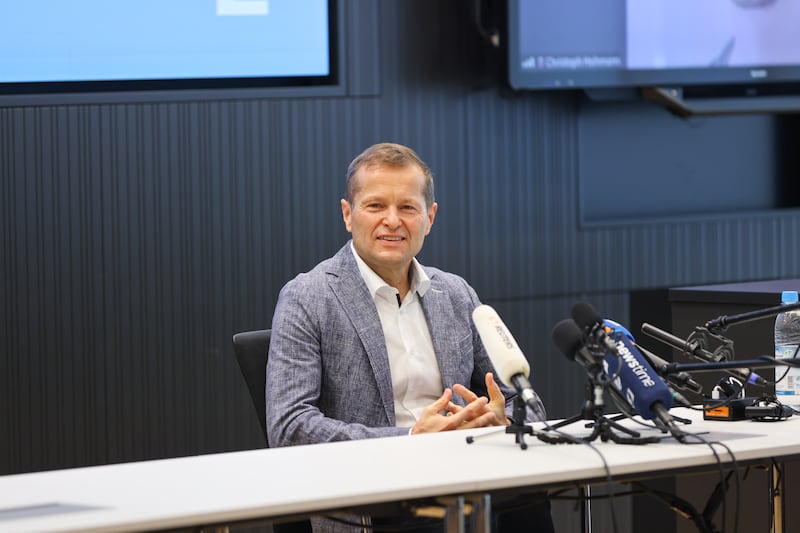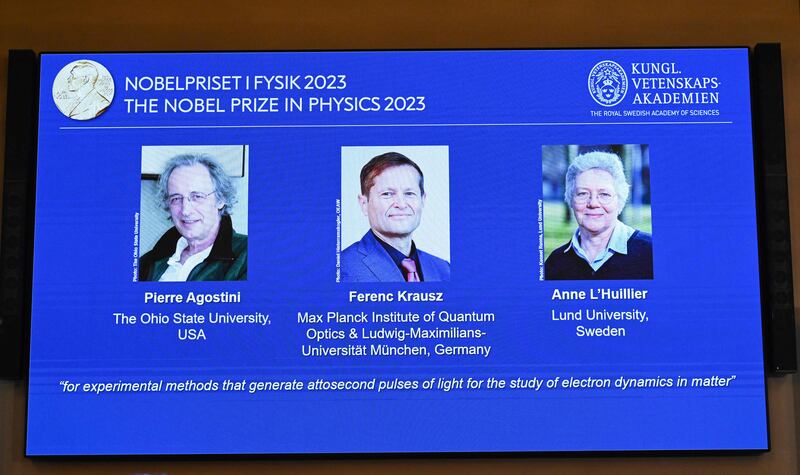Three scientists have been awarded the 2023 Nobel prize in physics for their work on creating extremely short pulses of light that can be harnessed to study processes occurring inside atoms and molecules.
Pierre Agostini, of Ohio State University, Ferenc Krausz, of Max Planck Institute of Quantum Optics, and Anne L’Huillier, of Lund University, will each receive equal shares of the 11 million Swedish kronor (€950,000) prize announced on Tuesday by the Royal Swedish Academy of Sciences in Stockholm.
This year’s award is the 117th Nobel prize to be presented in physics since 1901. Prof L’Huillier is only the fifth woman to receive the prize.
Speaking at the press conference, Prof L’Huillier, who herself sat on the Nobel committee for physics between 2007 and 2015, said she was teaching when she received the call to tell her she had won.
Desperate search for the 100,000 missing continues as life returns to the streets of Damascus
Crowds throng Syria’s ‘human slaughterhouse’ drawn by hopes of a miracle reunion
A van and a plan: House and furniture hunting in London is not for the faint of heart
Checkpoints and guard posts burned or abandoned on the road into Syria

“The last half-hour of my lecture was difficult to do,” she said. “As you know there are not so many women that get this prize, so it is very, very special,” she added.
The Nobel committee awarded the prize “for experimental methods that generate attosecond pulses of light for the study of electron dynamics in matter”.
An attosecond is a mind-bendingly short period of time. As the committee points out, the number of attoseconds that fit into one second – a timescale roughly equal to a heartbeat – is the same as the number of seconds that have passed since the birth of the universe. However, it is these timescales that govern electron dynamics. It takes about 150 attoseconds for an electron to orbit the nucleus of a hydrogen atom, while it takes electrons a few hundred attoseconds to jump from one atom to another.
This year’s winners devised experimental methods that use interactions between infrared laser light and a noble gas such as neon to produce pulses of light on the attosecond timescale. These pulses of light can be used to study the movements of electrons, and hence processes occurring within atoms and molecules.
Prof Mats Larsson, a member of the Royal Academy of Sciences, noted attosecond pulses had a number of important applications, with the technology offering the potential for ultra-fast switching of a material such as silicon dioxide from being an insulator to being a conductor.
“This is an important field because it gives you possibilities to develop very fast electronics based on these short pulses,” he said.
Another application under investigation, he said, was molecular fingerprinting of biological samples. For example, Prof Larrson said, very short pulses of light could be used to excite molecules within a blood sample. Infrared light emitted by the molecules could be then detected with attosecond precision, offering scientists a way to identify minute changes in the blood.
“By doing this, there is the hope in the future that you will be able to capture whether a person has developed, for example, lung cancer, so that you have a very sensitive method, and if you can diagnose cancer at a very early stage treatment will be much more successful,” Prof Larsson said.

Scientists have also suggested attosecond pulses of light could be used to investigate quantum processes involved in photosynthesis in plants, or to control chemical reactions – a field that has been dubbed “attochemistry”.
Dr Amelle Zair, of King’s College London, who has collaborated with Prof L’Huillier, said she was delighted and proud to see the trio’s win.
“Attosecond physics is a fascinating research area where powerful light interacts with matter to its most fundamental time scale, the attosecond time scale,” she said.
Prof Jon Marangos, of Imperial College London, the director of the Blackett Laboratory Laser Consortium, welcomed the news of the prize.
“This is a really well-deserved award to some of the pioneers of the field of attosecond science,” she said. “This capability is allowing us to investigate the very fastest electronic dynamics in matter that underpins photophysical and photochemical processes in all phases of matter.” – Guardian




